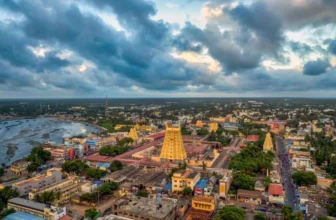The Iron Pillar of Delhi – A Metallurgical Marvel with Cosmic Clues
While not a temple in the traditional sense, the Iron Pillar located in the Qutb complex in Delhi is believed to have originally stood at the entrance of a Vishnu temple in Udayagiri (Madhya Pradesh) before it was relocated. This 1,600-year-old pillar, attributed to King Chandragupta II (circa 375–415 CE), is a scientific enigma, standing over 7 meters tall and weighing more than 6 tons — and it has not rusted despite centuries of exposure.
🧲 What Makes the Iron Pillar Scientifically Unique?
- Rust-Resistant Iron — No Modern Equivalent
Despite Delhi’s humidity and pollution, the pillar has remained free of corrosion for over 1,600 years. Scientists have studied it extensively, and found that:- The iron contains a very high phosphorus content, which forms a protective passive layer of iron hydrogen phosphate hydrate on the surface.
- No modern smelting process produces iron in this way without additives, meaning the technique is lost to time.
- Metallurgy of Spiritual Significance
The iron was forged using ancient cold crucible or hot co-forging methods, possibly in multiple small batches, and then welded with incredible uniformity — a process that required temperature control, oxygen regulation, and timing precision. - Cosmic Alignment & Foundation Energy
Ancient texts and architectural studies suggest that the pillar was originally aligned with celestial bodies during certain times of the year.
Some believe it was a dhvaja stambha (cosmic axis), symbolizing connection between Earth and the heavens, possibly linked to Vishnu’s Sudarshana Chakra as a cosmic stabilizer. - Geomagnetic Harmony
The original temple site (Udayagiri) and the pillar’s orientation reflect a subtle understanding of geomagnetic positioning. It’s said the site may have been selected based on magnetic ley lines — areas of natural energy flow, similar to Chinese feng shui or Vastu Shastra in India. - Inscription in Sanskrit & Spiritual Symbolism
The Sanskrit inscription on the pillar commemorates a mighty king who conquered the Vahlikas (possibly the Bactrians) and is thought to refer to Chandragupta II. The pillar thus stands not just as a metallurgical feat, but also as a historical time capsule, encoding a victory aligned with dharma and cosmic order.
🔬 Scientific Research & Theories
- IIT Kanpur & Indian Institute of Metals have analyzed the protective layer — known as “misawite” — which is only 1/20th of a millimeter thick, but incredibly resilient.
- The presence of slag inclusions, controlled cooling, and ancient forging techniques show knowledge of material behavior at a molecular level — without the use of modern thermodynamics.
- The lack of sulfur and manganese in the composition is now known to prevent long-term corrosion, which modern metallurgy only rediscovered in the 20th century.
🛕 Conclusion:
The Iron Pillar of Delhi may look simple at first glance, but it is an ancient nanotechnology, a symbol of divine order, and a metallurgical feat that has outlived kingdoms, conquests, and climate. It reminds us that ancient Indian artisans were not merely laborers — they were material scientists, astronomers, and engineers of the sacred.











